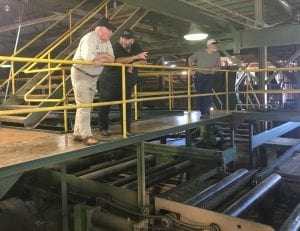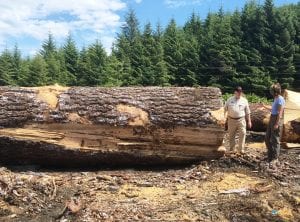
Agriculture Seretary Sonny Perdue and Alaska Sen. Lisa Murkowski listen to Kirk Dahlstrom of Viking Lumber in Klawock. The two officials toured Prince of Wales on June 5. (KRBD photo by Leila Kheiry)
While it’s been on the decline for years, logging remains an important segment of the economy in Southeast Alaska, particularly on Prince of Wales Island.
During their visit to POW on June 5th, Alaska Sen. Lisa Murkowski and Secretary of Agriculture Sonny Perdue heard from sawmill operators.
Audio PlayerIt’s a bright, sunny day and the fresh, clean smell of recently cut cedar permeates the air at Viking Lumber in Klawock.
The U.S. Secretary of Agriculture and Alaska’s senior senator lean against the hood of a pickup truck while Viking co-owner Kirk Dahlstrom talks about the challenges of running a sawmill.
He said they bought the mill in 1994, and operated steadily since then.
“And we have been just about out of timber three times because there were no sales,” he said. “But we survived.”
Viking is a major employer on Prince of Wales. Dahlstrom said considering everyone related to mill activities, they provide around 145 direct jobs.

Secretary of Agriculture Sonny Perdue talks with Viking Lumber co-owner Kirk Dalhstrom while touring the Klawock sawmill. (KRBD photo by Leila Kheiry)
“And that’s really big on this island,” he said. “And I think, well I know we are the largest year-round employer on the island.”
And those jobs depend on a steady supply of trees – old-growth trees.
Viking also is only remaining large mill in Alaska. There are small operators still around, though.
Desiree Janzen owns K&D Lumber, a small mill near Thorne Bay. Earlier that day, during a meeting in Klawock, she told Perdue and Murkowski that her business has survived by the skin of its teeth. They want to do more than survive, though; they want to grow.
Janzen said they can’t do that without knowing timber will be available in the future.
“That’s what I’m asking for is some kind of sustainable usage,” she said. “We might use 2 million feet of old-growth in a year is what we might manufacture. We’d really like to see something. If we want our kids to have this mill, which right now we’re questioning whether or not we really want to give it to them.”
A sustainable, predictable timber supply is on a list submitted by the Prince of Wales Landscape Assessment Team. That group met for a year to come up with recommendations for future U.S. Forest Service projects on the island, and they met with Perdue and Murkowski during their visit to POW.
Earlier that day in Ketchikan, Forest Service Silviculturalist Sheila Spores gave a closed-door presentation for Perdue about old-growth on the Tongass, and a planned transition to new-growth timber harvest.
She was going to expand on that presentation during a visit to a stand of old-growth on Prince of Wales, but the van we were in developed some problems and couldn’t make it up a steep section of logging road.
While we waited at the bottom of the hill for everyone else to come back down, Spores gave me a summary. She said during the morning presentation, Perdue asked about the controversy surrounding old-growth, and they discussed the value some people place on untouched forest.
“And so, hence that’s why we began the whole transition to young growth, how can we get out of old-growth, leave the controversy behind and move into something that was not supposed to be controversial,” she said.
The transition from old-growth timber harvest to young-growth started under President Barack Obama’s administration. Timber industry representatives say the 15-year transition is too quick and the trees aren’t ready, while conservation groups argue the transition needs to happen sooner to protect old-growth.
Perdue and Murkowski also visited a young-growth stand on POW that was cut in the 1960s. That stand is

Secretary of Agriculture Sonny Perdue and Alaska Sen. Lisa Murkowski look at some old-growth logs in the yard at Viking Lumber in Klawock. The two toured Prince of Wales Island on June 5. (KRBD photo by Leila Kheiry)
around 50 years old, Spores said, which is the age of most Tongass young-growth stands. And timber buyers generally aren’t interested in the trees until they are 60 to 75 years old.
So, in 10 to 15 years, Spores said, “We’re going to have a lot. So, if someone were interested in it today, we could sell it. But the whole point is, right now, people want a little bit bigger stuff and we don’t have a lot of it, but we have a lot coming. We call it the wall of wood.”
Until that wall arrives, though, old growth likely will be the only marketable timber. The Prince of Wales group recommended a continued, albeit slowly phased-out, supply of old-growth timber through 2028, at least.
During the meeting in Klawock, Perdue told POW Landscape Assessment Team members that local interest will be seriously considered during future planning efforts.
“So we can benefit, first of all, economy, the recreation, the fishing industry, timber jobs, supporting schools, all those kind of things that make sense for a vibrant community,” Perdue said.
The U.S. Forest Service is under the Department of Agriculture, so Perdue oversees that and other federal agencies. His visit to Prince of Wales Island was the last stop on a quick tour of Pacific Northwest federal sites. He also made stops in Washington State, Oregon and Idaho.
Here is one link to an earlier story about Perdue’s visit to Prince of Wales Island, and here is another.





